The Development of a Composite Thin Film Barrier of Tungsten Fe3O4-rGO (FerGO) for the Radiation Shielding of Medical Personnel
Abstract
:1. Introduction
2. Methods and Materials
2.1. Radiation Shielding Mechanism
2.2. Materials
2.3. GO Synthesis
2.4. Fe3O4-rGO(FerGO) Synthesis
2.5. Manufacturing Thin Film Sheets Using Nanofibers
2.6. Radiation Shielding Experiment
3. Results
3.1. Synthesis Results of GO and FerGO
3.2. Evaluation of the Shielding Performance of Thin Film Sheets and Standard Lead
4. Discussion
5. Conclusions
Author Contributions
Funding
Institutional Review Board Statement
Informed Consent Statement
Data Availability Statement
Conflicts of Interest
References
- Hayda, R.A.; Hsu, R.Y.; DePasse, J.M.; Gil, J.A. Radiation Exposure and Health Risks for Orthopaedic Surgeons. J. Am. Acad. Orthop. Surg. 2018, 26, 268–277. [Google Scholar] [CrossRef] [PubMed]
- Eyssa, H.M.; Sadek, R.F.; Mohamed, W.S.; Ramadan, W. Structure-Property Behavior of Polyethylene Nanocomposites Containing Bi2O3 and WO3 as an Eco-Friendly Additive for Radiation Shielding. Ceram. Int. 2023, 49, 18442–18454. [Google Scholar] [CrossRef]
- Ko, S.; Kang, S.; Ha, M.; Kim, J.; Jun, J.K.; Kong, K.A.; Lee, W.J. Health Effects from Occupational Radiation Exposure among Fluoroscopy-Guided Interventional Medical Workers: A Systematic Review. J. Vasc. Interv. Radiol. 2018, 29, 353–366. [Google Scholar] [CrossRef] [PubMed]
- Rühm, W.; Azizova, T.; Bouffler, S.; Cullings, H.M.; Grosche, B.; Little, M.P.; Shore, R.S.; Walsh, L.; Woloschak, G.E. Typical Doses and Dose Rates in Studies Pertinent to Radiation Risk Inference at Low Doses and Low Dose Rates. J. Radiat. Res. 2018, 59, ii1–ii10. [Google Scholar] [CrossRef] [PubMed]
- Tang, F.R.; Loganovsky, K. Low Dose or Low Dose Rate Ionizing Radiation-Induced Health Effect in the Human. J. Environ. Radioact. 2018, 192, 32–47. [Google Scholar] [CrossRef] [PubMed]
- Siegel, J.A.; Greenspan, B.S.; Maurer, A.H.; Taylor, A.T.; Phillips, W.T.; Van Nostrand, D.; Sacks, B.; Silberstein, E.B. The BEIR VII Estimates of Low-Dose Radiation Health Risks Are Based on Faulty Assumptions and Data Analyses: A Call for Reassessment. J. Nucl. Med. 2018, 59, 1017–1019. [Google Scholar] [CrossRef] [PubMed]
- Kim, S.-C. Process Technology for Development and Performance Improvement of Medical Radiation Shield Made of Eco-Friendly Oyster Shell Powder. Appl. Sci. 2022, 12, 968. [Google Scholar] [CrossRef]
- Agrawal, R.; Shah, J.; Gupta, G.; Srivastava, R.; Sharma, C.; Kotnala, R. Significantly High Electromagnetic Shielding Effectiveness in Polypyrrole Synthesized by Eco-friendly and Cost-effective Technique. J. Appl. Polym. Sci. 2020, 137, 49566. [Google Scholar] [CrossRef]
- Abdolahzadeh, T.; Morshedian, J.; Ahmadi, S. Novel Polyethylene/Tungsten Oxide/Bismuth Trioxide/Barium Sulfate/Graphene Oxide Nanocomposites for Shielding against X-ray Radiations. Int. J. Radiat. Res. 2023, 21, 79–87. [Google Scholar] [CrossRef]
- Sayyed, M.I. The Impact of Chemical Composition, Density and Thickness on the Radiation Shielding Properties of CaO–Al2O3–SiO2 Glasses. Silicon 2023, 15, 7917–7926. [Google Scholar] [CrossRef]
- Tang, D.; Wang, Q.; Wang, Z.; Liu, Q.; Zhang, B.; He, D.; Wu, Z.; Mu, S. Highly Sensitive Wearable Sensor Based on a Flexible Multi-Layer Graphene Film Antenna. Sci. Bull. 2018, 63, 574–579. [Google Scholar] [CrossRef] [PubMed]
- Khan, A.; Nilam, B.; Rukhsar, C.; Sayali, G.; Mandlekar, B.; Kadam, A. A Review Article Based on Composite Graphene @tungsten Oxide Thin Films for Various Applications. Tungsten 2022, 5, 391–418. [Google Scholar] [CrossRef]
- Khan, S.A.; Ali, B.; Eze, C.; Lau, K.T.; Ali, L.; Chen, J.; Zhao, J. Magnetic Dipole and Thermal Radiation Impacts on Stagnation Point Flow of Micropolar Based Nanofluids over a Vertically Stretching Sheet: Finite Element Approach. Processes 2021, 9, 1089. [Google Scholar] [CrossRef]
- Chen, D.; Kuzmenko, I.; Ilavsky, J.; Pinho, L.; Campanella, O. Structural evolution during gelation of pea and whey proteins envisaged by time-resolved ultra-small-angle X-ray scattering (USAXS). Food Hydrocoll. 2022, 126, 107449. [Google Scholar] [CrossRef]
- Azman, M.N.; Abualroos, N.J.; Yaacob, K.A.; Zainon, R. Feasibility of nanomaterial tungsten carbide as lead-free nanomaterial-based radiation shielding. Radiat. Phys. Chem. 2023, 202, 110492. [Google Scholar] [CrossRef]
- Zhang, W.; Wei, L.; Ma, Z.; Fan, Q.; Ma, J. Advances in waterborne polymer/carbon material composites for electromagnetic interference shielding. Carbon 2021, 177, 412–426. [Google Scholar] [CrossRef]
- Yavuz, M.; Özdemİr, N. Analysis of an epidemic spreading model with exponential decay law. Math. Sci. Appl. E-Notes 2020, 8, 142–154. [Google Scholar] [CrossRef]
- Al-Hadeethi, Y.; Sayyed, M.I. The influence of PbO on the radiation attenuation features of tellurite glass. Ceram. Int. 2019, 45, 24230–24235. [Google Scholar] [CrossRef]
- Lai, M.-F.; Huang, C.-H.; Lou, C.-W.; Chuang, Y.-C.; Wei, C.-Y.; Lin, J.-H. Multi-walled carbon nanotubes/polypropylene-based coating layer on the composite metal filaments: Characteristic evaluations and radiation-shielded fabric. Fibers Polym. 2022, 23, 768–774. [Google Scholar] [CrossRef]
- Mahmoud, M.E.; El-Khatib, A.M.; Badawi, M.S.; Rashad, A.R.; El-Sharkawy, R.M.; Thabet, A.A. Recycled high-density polyethylene plastics added with lead oxide nanoparticles as sustainable radiation shielding materials. J. Clean. Prod. 2018, 176, 276–287. [Google Scholar] [CrossRef]
- Gökçe, H.S.; Öztürk, B.C.; Çam, N.F.; Andiç-Çakır, Ö. Gamma-ray attenuation coefficients and transmission thickness of high consistency heavyweight concrete containing mineral admixture. Cem. Concr. Compos. 2018, 92, 56–69. [Google Scholar] [CrossRef]
- Mahmoud, M.E.; El-Khatib, A.M.; Badawi, M.S.; Rashad, A.R.; El-Sharkawy, R.M.; Thabet, A.A. Fabrication, characterization and gamma rays shielding properties of nano and micro lead oxide-dispersed-high density polyethylene composites. Radiat. Phys. Chem. 2018, 145, 160–173. [Google Scholar] [CrossRef]
- Oyedotun, T.D.T. X-ray fluorescence (XRF) in the investigation of the composition of earth materials: A review and an overview. Geol. Ecol. Landsc. 2018, 2, 148–154. [Google Scholar] [CrossRef]
- Sujiono, E.; Zurnansyah; Zabrian, D.; Dahlan, M.; Amin, B.; Samnur; Agus, J. Graphene oxide based coconut shell waste: Synthesis by modified Hummers method and characterization. Heliyon 2020, 6, e04568. [Google Scholar] [CrossRef]
- Qu, J.; Li, S.; Yang, X.; Zheng, C.; Cai, Y.; Sun, W.; Hu, J.; Li, C.M. Hollow porous Co–Ni spinel nanosheet arrays with rich oxygen defects on carbon cloth toward highly efficient and selective CO2 photofixation. Carbon 2022, 200, 149–155. [Google Scholar] [CrossRef]
- Cai, Y.; Sun, Q.; Sun, L.; Long, X.; Ji, T.; Ye, W. Effect of preparation conditions on structure and electromagnetic wave absorption properties of sandwich-like Fe3O4-rGO nanocomposites. J. Magn. Magn. Mater. 2020, 503, 166656. [Google Scholar] [CrossRef]
- Zhang, Q.; Liu, L.; Zhu, Z.; Ni, Y. Functionalization of Fe3O4/rGO Magnetic Nanoparticles with Resveratrol and in vitro DNA Interaction. Spectrochim. Acta Part A 2022, 273, 1386–1425. [Google Scholar] [CrossRef]
- Adlienė, D.; Gilys, L.; Griškonis, E. Development and characterization of new tungsten and tantalum containing composites for radiation shielding in medicine. Nucl. Instrum. Methods Phys. Res. Sect. B 2020, 467, 21–26. [Google Scholar] [CrossRef]
- Song, X.; He, W.; Qin, H.; Yang, S.; Wen, S. Fused Deposition Modeling of Poly (lactic acid)/Macadamia Composites—Thermal, Mechanical Properties and Scaffolds. Materials 2020, 13, 258. [Google Scholar] [CrossRef]
- Ma, Y.; Zhang, H.; Lin, R.; Ai, Y.; Lan, K.; Duan, L.; Chen, W.; Duan, X.; Ma, B.; Wang, C.; et al. Remodeling nanodroplets into hierarchical mesoporous silica nanoreactors with multiple chambers, Muhammad Qaisar Sultan. Sci. Rep. 2022, 13, 6136. [Google Scholar]
- Kim, S.C.; Son, J.S. Manufacturing and performance evaluation of medical radiation shielding fiber with plasma thermal spray coating technology. Sci. Rep. 2021, 11, 22418. [Google Scholar] [CrossRef]
- Chang, Q.; Guo, S.; Zhang, X. Radiation shielding polymer composites: Ray-interaction mechanism, structural design, manufacture and biomedical applications. Mater. Des. 2023, 233, 112253. [Google Scholar] [CrossRef]
- Abdullaev, R.N.; Khairulin, R.A.; Kozlovskii, Y.M.; Agazhanov, A.S.; Stankus, S.V. Density of magnesium and magnesium-lithium alloys in solid and liquid states. Trans. Nonferrous Met. Soc. China 2019, 29, 507–514. [Google Scholar] [CrossRef]
- Fan, C.; Wu, B.; Song, R.; Zhao, Y.; Zhang, Y.; He, D. Electromagnetic shielding and multi-beam radiation with high conductivity multilayer graphene film. Carbon 2019, 155, 506–513. [Google Scholar] [CrossRef]
- Gong, J.; Lin, X. Facilitated Electron Transfer of Hemoglobin Embedded in Nanosized Fe3O4 Matrix Based on Paraffin Impregnated Graphite Electrode and Electrochemical Catalysis for Trichloroacetic Acid. Microchem. J. 2003, 75, 51–57. [Google Scholar] [CrossRef]
- Liao, M.-H.; Chen, D.-H. Immobilizing of Yeast Alcohol Dehydrogenase on Magnetic Nanoparticles of Improving its Stability. Biotechnol. Lett. 2001, 23, 1723–1727. [Google Scholar] [CrossRef]
- Liu, J.; Mckeon, L.; Garcia, J.; Pinilla, S.; Barwich, S.; Möbius, M.; Stamenov, P.; Coleman, J.N.; Nicolosi, V. Additive manufacturing of Ti3C2-MXene-functionalized conductive polymer hydrogels for electromagnetic-interference shielding. Adv. Mater. 2022, 34, 2106253. [Google Scholar] [CrossRef] [PubMed]
- Xiong, C.; Li, M.; Han, Q.; Zhao, W.; Dai, L.; Ni, Y. Screen printing fabricating patterned and customized full paper-based energy storage devices with excellent photothermal, self-healing, high energy density and good electromagnetic shielding performances. J. Mater. Sci. Technol. 2022, 97, 190–200. [Google Scholar] [CrossRef]
- Cowan, G.; Cranmer, K.; Gross, E.; Vitells, O. Asymptotic formulae for likelihood-based tests of new physics. Eur. Phys. J. C 2011, 71, 1554. [Google Scholar] [CrossRef]
- Aral, N.; Duch, M.A.; Ardanuy, M. Material characterization and Monte Carlo simulation of lead and non-lead X-Ray shielding materials. Radiat. Phys. Chem. 2020, 174, 108892. [Google Scholar] [CrossRef]
- González-Henríquez, C.M.; Sarabia-Vallejos, M.A.; Rodriguez-Hernandez, J. Polymers for additive manufacturing and 4D-printing: Materials, methodologies, and biomedical applications. Prog. Polym. Sci. 2019, 94, 57–116. [Google Scholar] [CrossRef]
- Zhang, H.; Chung, H.T.; Cullen, D.A.; Wagner, S.; Kramm, U.I.; More, K.L.; Zelenay, P.; Wu, G. High-performance fuel cell cathodes exclusively containing atomically dispersed iron active sites. Energy Environ. Sci. 2019, 12, 2548–2558. [Google Scholar] [CrossRef]

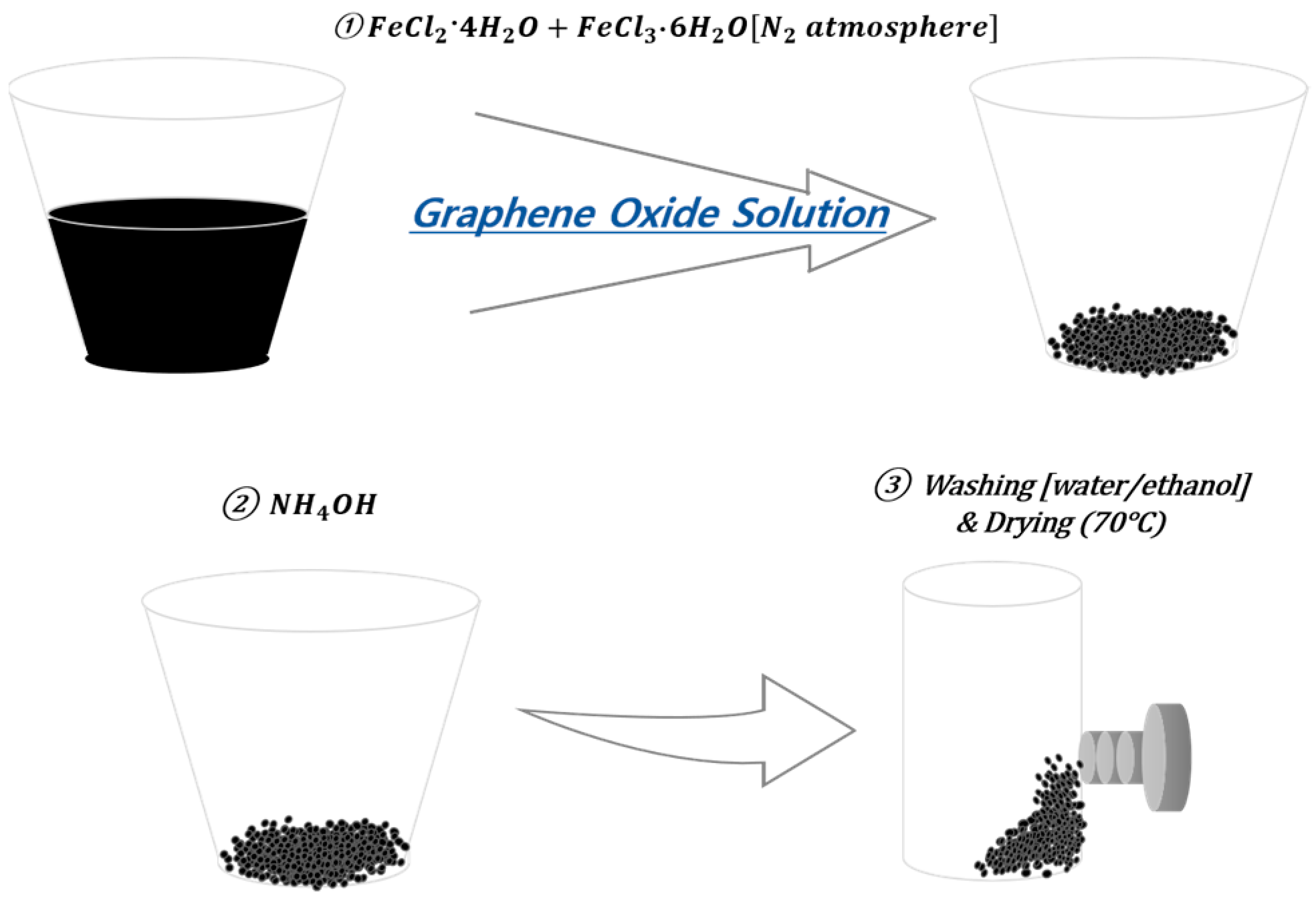

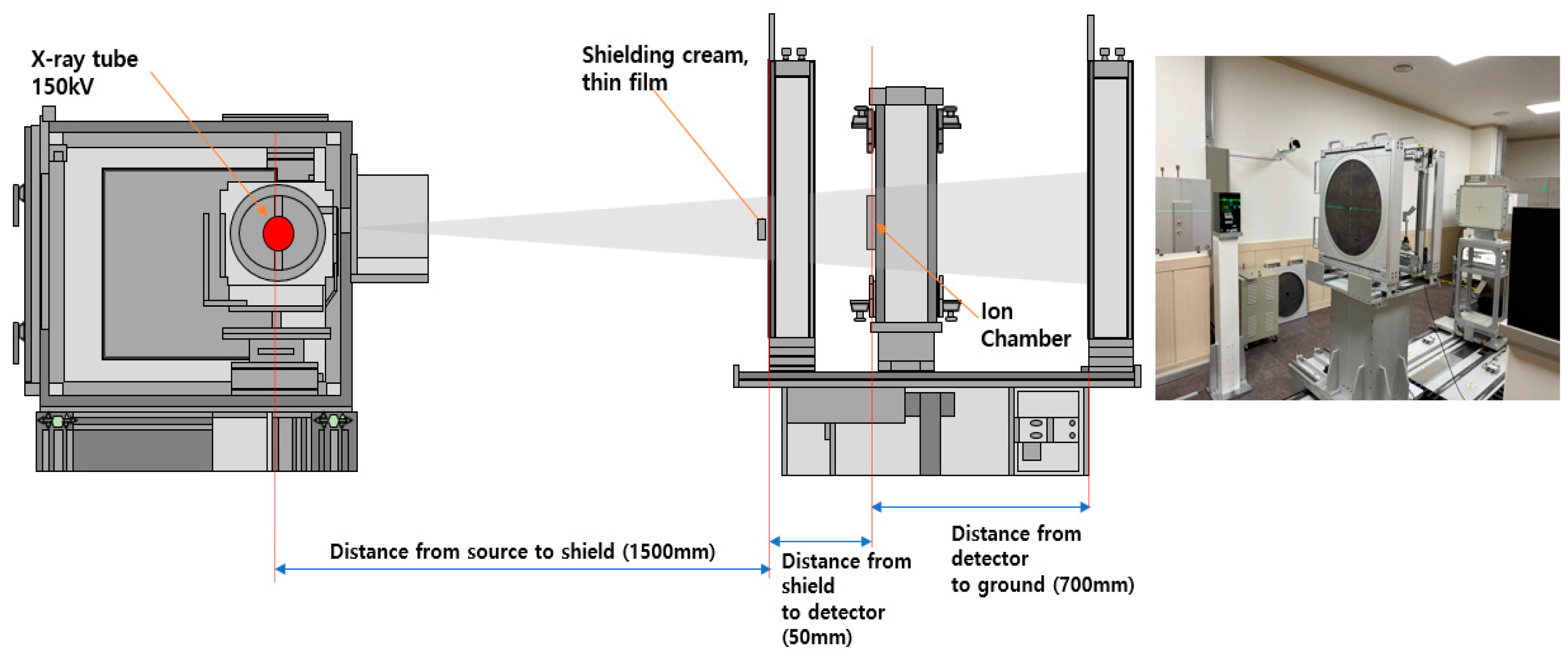
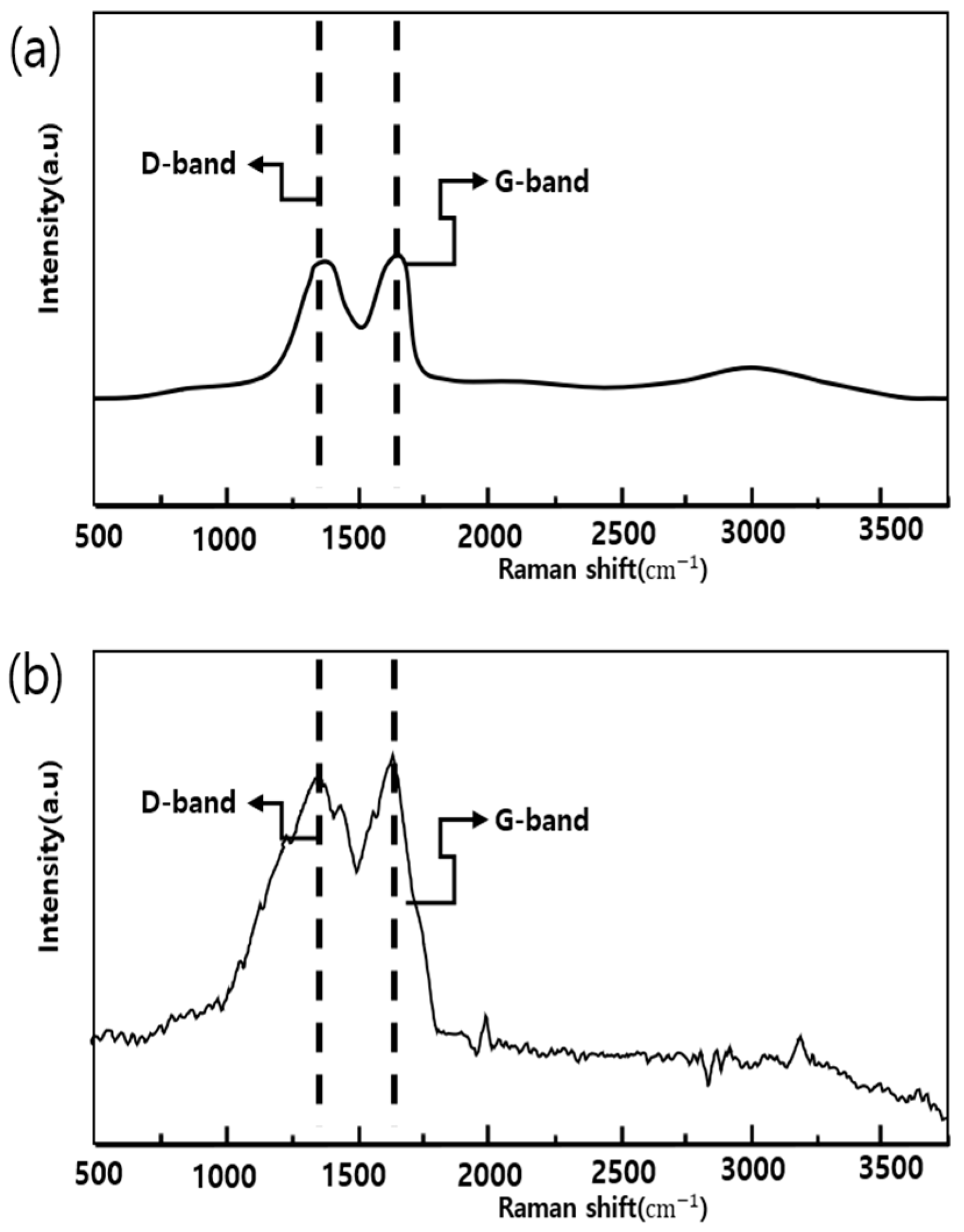
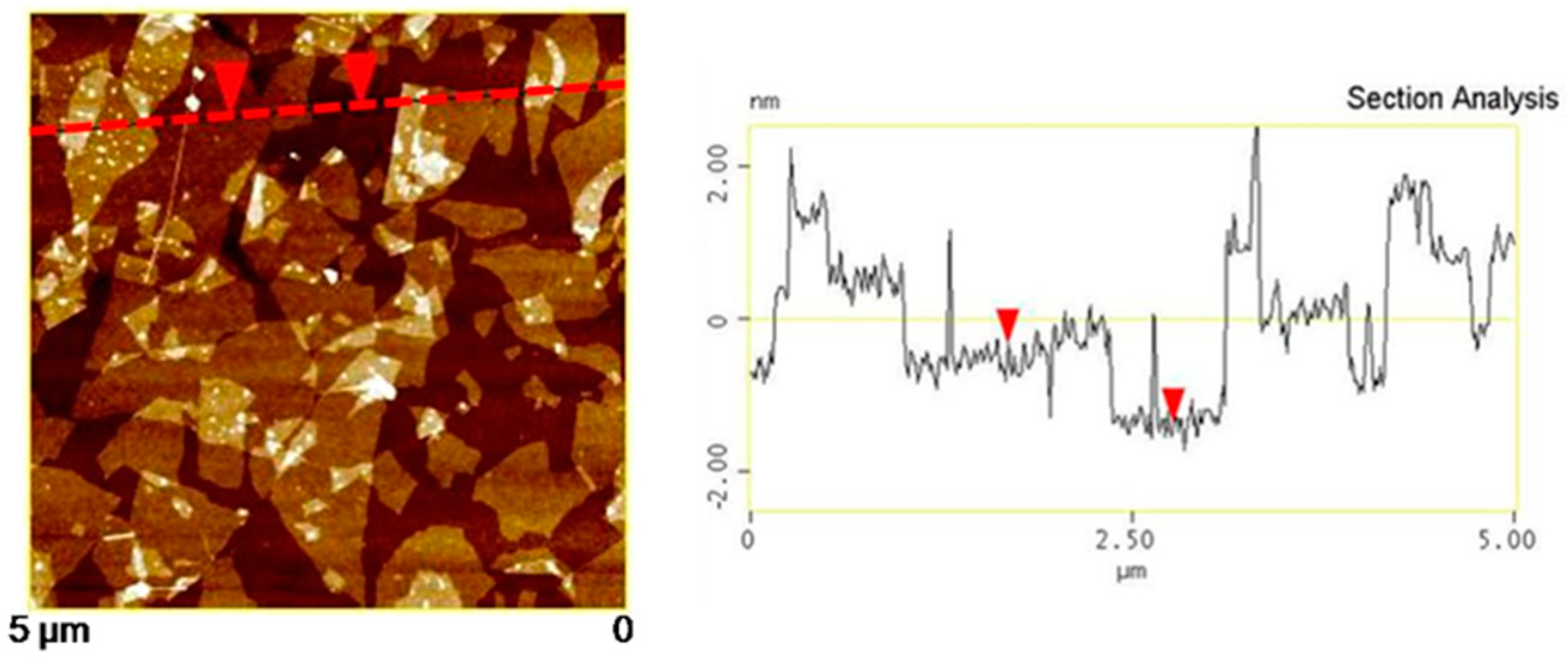
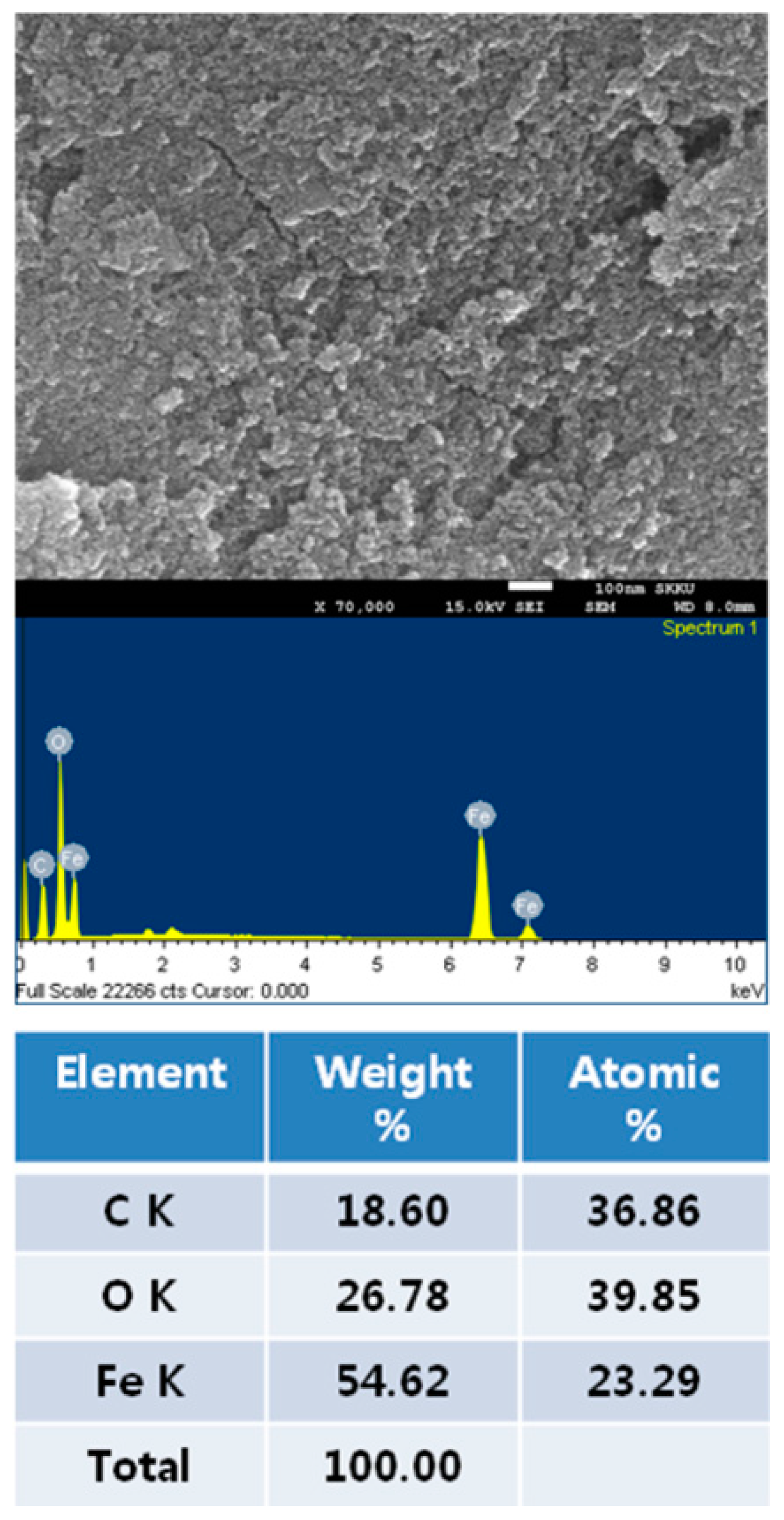
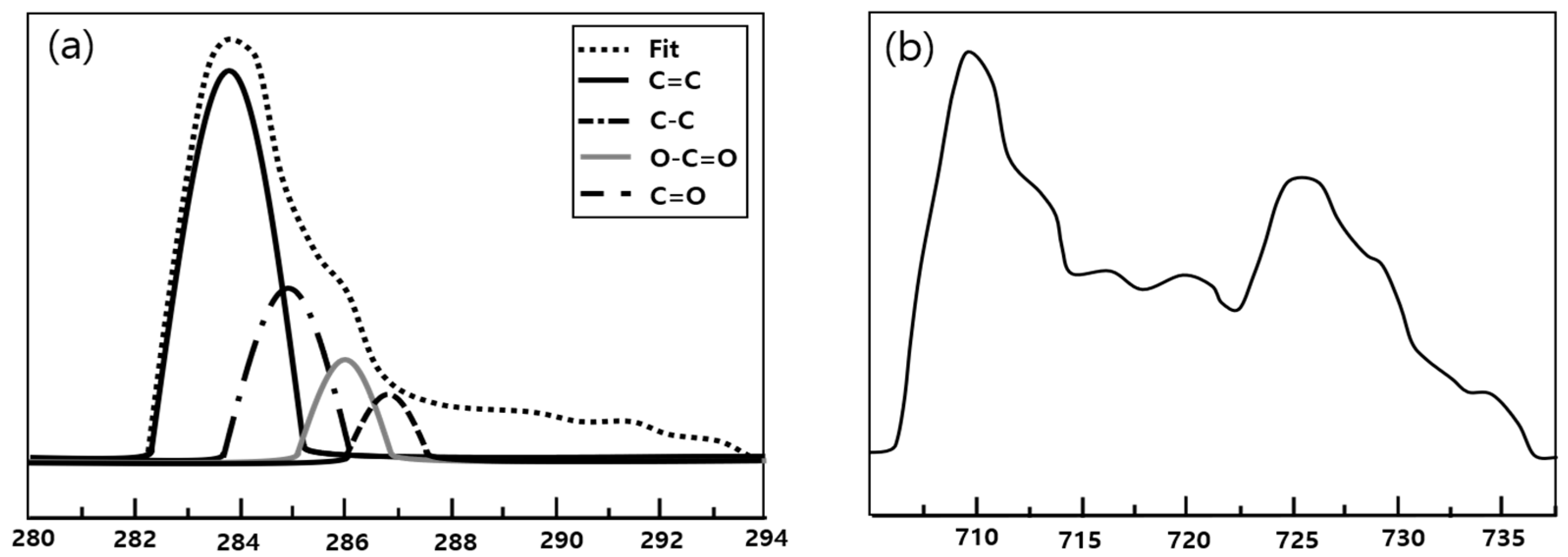

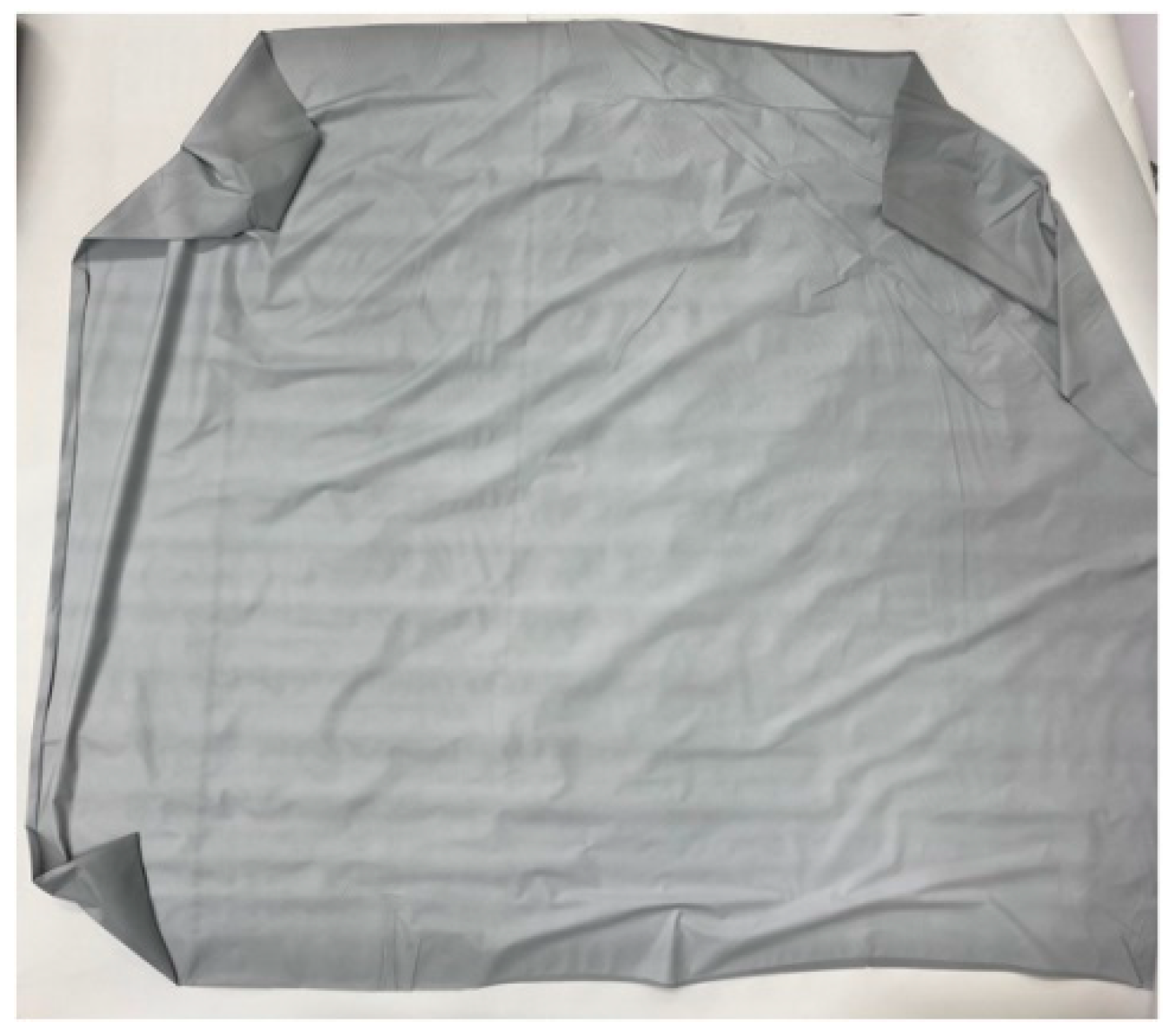

| Type * | Weight (kg/m2) | Shielding Material Weight (kg/m2) | Thickness (mm) | Density (g/cm3) |
|---|---|---|---|---|
| A | 0.525 0.020 | 0.183 0.028 (Tungsten only) | 0.300 0.020 | 1.941 0.065 |
| B | 0.652 0.034 | 0.104 0.028 (Tungsten and FerGO) | 2.302 0.142 |
| mmPb | Transmission Dose | 60 kVp | 80 kVp | 100 kVp | 120 kVp | ||||
|---|---|---|---|---|---|---|---|---|---|
| None | Lead | None | Lead | None | Lead | None | Lead | ||
| 0.1 | Dose (μR) | 420.15 | 74.74 | 886.78 | 261.25 | 1521.23 | 567.27 | 1997.75 | 827.87 |
| Shielding rate (%) | 82.21 | 70.54 | 62.71 | 58.56 | |||||
| 0.2 | Dose (μR) | 420.15 | 22.86 | 886.78 | 125.92 | 1521.23 | 326.46 | 1997.75 | 475.26 |
| Shielding rate (%) | 94.56 | 85.89 | 78.54 | 76.21 | |||||
| 0.3 | Dose (μR) | 420.15 | 8.49 | 886.78 | 70.85 | 1521.23 | 204.76 | 1997.75 | 293.26 |
| Shielding rate (%) | 97.98 | 92.01 | 86.54 | 85.32 | |||||
| Thickness (mm) | Transmission Dose | 60 kVp | 80 kVp | 100 kVp | 120 kVp | ||||
|---|---|---|---|---|---|---|---|---|---|
| Non | SB | Non | SB | Non | SB | Non | SB | ||
| 0.1 | Dose (μR) | 420.15 | 83.53 | 886.78 | 243.51 | 1521.23 | 589.63 | 1997.75 | 874.42 |
| Shielding rate (%) | 80.12 | 72.54 | 61.24 | 56.23 | |||||
| Lead equivalent (mmPb) | 0.097 | 0.103 | 0.098 | 0.096 | |||||
| 0.2 | Dose (μR) | 420.15 | 34.23 | 886.78 | 110.76 | 1521.23 | 228.80 | 1997.75 | 324.04 |
| Shielding rate (%) | 91.85 | 87.51 | 84.96 | 83.78 | |||||
| Lead equivalent (mmPb) | 0.206 | 0.196 | 0.185 | 0.182 | |||||
| 0.3 | Dose (μR) | 420.15 | 19.24 | 886.78 | 51.34 | 1521.23 | 106.79 | 1997.75 | 188.19 |
| Shielding rate (%) | 95.42 | 94.21 | 92.98 | 90.58 | |||||
| Lead equivalent (mmPb) | 0.305 | 0.293 | 0.279 | 0.283 | |||||
Disclaimer/Publisher’s Note: The statements, opinions and data contained in all publications are solely those of the individual author(s) and contributor(s) and not of MDPI and/or the editor(s). MDPI and/or the editor(s) disclaim responsibility for any injury to people or property resulting from any ideas, methods, instructions or products referred to in the content. |
© 2024 by the authors. Licensee MDPI, Basel, Switzerland. This article is an open access article distributed under the terms and conditions of the Creative Commons Attribution (CC BY) license (https://creativecommons.org/licenses/by/4.0/).
Share and Cite
Kim, S.-C.; Hou, J.; Jang, W.-G.; Byun, H.-S. The Development of a Composite Thin Film Barrier of Tungsten Fe3O4-rGO (FerGO) for the Radiation Shielding of Medical Personnel. Polymers 2024, 16, 215. https://doi.org/10.3390/polym16020215
Kim S-C, Hou J, Jang W-G, Byun H-S. The Development of a Composite Thin Film Barrier of Tungsten Fe3O4-rGO (FerGO) for the Radiation Shielding of Medical Personnel. Polymers. 2024; 16(2):215. https://doi.org/10.3390/polym16020215
Chicago/Turabian StyleKim, Seon-Chil, Jian Hou, Won-Gi Jang, and Hong-Sik Byun. 2024. "The Development of a Composite Thin Film Barrier of Tungsten Fe3O4-rGO (FerGO) for the Radiation Shielding of Medical Personnel" Polymers 16, no. 2: 215. https://doi.org/10.3390/polym16020215
APA StyleKim, S.-C., Hou, J., Jang, W.-G., & Byun, H.-S. (2024). The Development of a Composite Thin Film Barrier of Tungsten Fe3O4-rGO (FerGO) for the Radiation Shielding of Medical Personnel. Polymers, 16(2), 215. https://doi.org/10.3390/polym16020215








